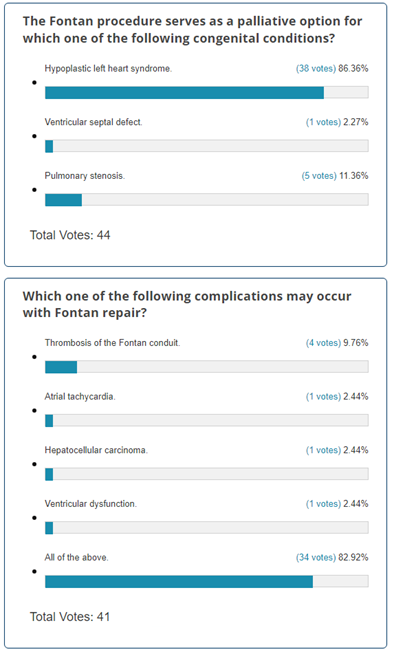Poll Results: A Puzzling Jigsaw Tale of a Patient With a History of Congenital Heart Disease Presenting With Syncope
This poll included the following clinical vignette: A 26-year-old woman with a history of cardiac surgeries (unknown details) presents with syncope and palpitations. Records obtained from outside institutions show that she has a history of dextrocardia with situs solitus, atrioventricular (AV) and ventricular arterial discordance with pulmonary atresia, and right ventricular (RV) hypoplasia with a large ventricular septal defect (VSD). In childhood, she underwent fenestrated lateral tunnel Fontan repair. Later, at 4 years of age, she underwent transcatheter closure of baffle leak and closure of Fontan fenestration with no residual shunt.
The aim of the poll questions was to ascertain whether readers understand the indications for a Fontan procedure and its associated complications.

The results of the first poll question show that most readers are aware of the indications for a Fontan repair. This result is encouraging, especially as many of these patients with Fontan repair are surviving childhood and will increasingly present to the adult cardiologist. It is therefore very important for adult cardiologists to be aware of this procedure and its indications. As was evident in this case presentation, this patient was unaware of the details of her surgery and of the indication for the surgery. Unfortunately, her mother was deceased and the patient did not know the full details of her condition. Only after the cardiologist obtained the operative report was it clear that underlying congenital heart disease (CHD) was present along with the surgical procedures performed. This situation is often the case for patients with CHD. Therefore, it is imperative that all operative reports are obtained when evaluating these patients, as this is a crucial step prior to determining the best management plan.
The Fontan procedure is often the procedure that serves as a final palliative option for patients born with complex CHD. Specifically, Fontan circulation is used in patients with CHD with congenital defects for whom biventricular circulation is not possible, either due to RV or left ventricular (LV) hypoplasia. Now at approximately 50 years since its inception, the Fontan procedure has evolved, with technical and operative modifications yielding increased survival of patients with complex CHD.
In patients born with only one functional ventricle, this single ventricle often carries blood to the systemic circulation and to the lungs via an obligatory intracardiac shunt, which is oftentimes a large VSD or atrial septal defect. Therefore, these patients will have mixing of saturated and desaturated blood resulting in resting hypoxemia before Fontan repair. With Fontan correction, the procedure diverts systemic venous return to the lungs, bypassing the heart via the Fontan circuit. However, the single systemic ventricle only supplies blood to the systemic arterial flow. This anatomy thus avoids any intracardiac mixing of saturated and desaturated blood, and therefore decreases the resting hypoxemia. Hypoplastic left heart syndrome, tricuspid atresia, hypoplastic right heart syndrome, pulmonary atresia with intact ventricular septum, double-inlet LV, unbalanced AV canal defects, and some cases of Ebstein anomalies with diminutive RV are all congenital defects for which the Fontan procedure could be considered.
The results of the second poll question indicate that most readers are aware of the potential complications of the Fontan repair. It is crucial that cardiologists are aware of the complications with Fontan physiology because these are multisystemic and often life-threatening. Therefore, although the procedure has evolved over the previous few decades, clinicians caring for these patients must look out for these complications. Close examination and routine multimodality imaging evaluation of the Fontan conduit, patient's functional status, and ventricular function are necessary in identifying complications. This identification also requires a multidisciplinary approach, as some of these complications may be arrhythmic in nature and may involve other organ systems such as the lungs, hepatobiliary system, or gastrointestinal tract. Caring for these patients may also require transfer to an established CHD referral center with expertise in managing patients with Fontan physiology.
The poll results show that ongoing education of complex CHD and its long-term complications are necessary to continue caring for patients with these conditions who have undergone surgical palliation with Fontan repair. For more on these teaching points, see the Suggested Readings.
Suggested Readings:
- Rychik J, Atz AM, Celermajer DS, et al.; American Heart Association Council on Cardiovascular Disease in the Young and Council on Cardiovascular and Stroke Nursing. Evaluation and management of the child and adult with Fontan circulation: a scientific statement from the American Heart Association. Circulation 2019;140:e234-e284.
- Mazza GA, Gribaudo E, Agnoletti G. The pathophysiology and complications of Fontan circulation. Acta Biomed 2021;92:[ePub ahead of print].
- Stout KK, Daniels CJ, Aboulhosn JA, et al. 2018 AHA/ACC guideline for the management of adults with congenital heart disease: a report of the American College of Cardiology/American Heart Association Task Force on Clinical Practice Guidelines. J Am Coll Cardiol 2019;73:e81-e192.
- Sachdeva R, Valente AM, Armstrong AK, et al. ACC/AHA/ASE/HRS/ISACHD/SCAI/SCCT/SCMR/SOPE 2020 appropriate use criteria for multimodality imaging during the follow-up care of patients with congenital heart disease: a report of the American College of Cardiology Solution Set Oversight Committee and Appropriate Use Criteria Task Force, American Heart Association, American Society of Echocardiography, Heart Rhythm Society, International Society for Adult Congenital Heart Disease, Society for Cardiovascular Angiography and Interventions, Society of Cardiovascular Computed Tomography, Society for Cardiovascular Magnetic Resonance, and Society of Pediatric Echocardiography. J Am Coll Cardiol 2020;75:657-703.
Clinical Topics: Cardiac Surgery, Congenital Heart Disease and Pediatric Cardiology, Invasive Cardiovascular Angiography and Intervention, Vascular Medicine, Cardiac Surgery and CHD and Pediatrics, Congenital Heart Disease, CHD and Pediatrics and Interventions, Interventions and Structural Heart Disease, Interventions and Vascular Medicine, Noninvasive Imaging
Keywords: Fontan Procedure, Heart Defects, Congenital, Syncope, Venous Thrombosis, Computed Tomography